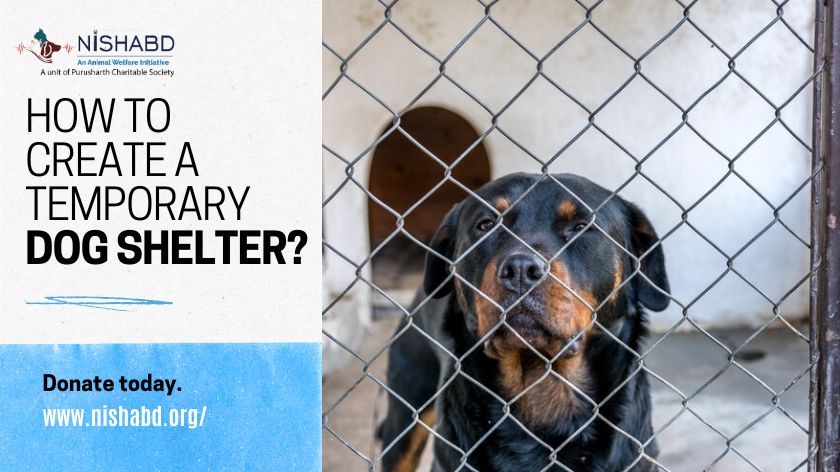How to Create a Temporary Dog Shelter: Essential Tips and Considerations
In the case of an emergency, a well-organized temporary shelter will offer security, comfort, and assistance for your dog until a permanent solution is found. This guide will guide you through the most important suggestions and guidelines to ensure that your dog’s shelter in the interim is safe, humane and well-maintained. It is a question in mind i.e. how to make a temporary shelter? Here are some solutions to pre and post temporary shelter care:
- Planning and Preparation
When constructing a temporary dog shelter it is important to plan thoroughly. Think about some of the steps below:- Assess the Need: Decide on the amount of dogs you are planning to be able to accommodate. This will assist you in planning the area, supplies and the staff you will need.
- Location Selection: Select a secure, accessible place that is large enough to accommodate exercise areas, kennels, as well as facilities for staff and volunteers.
- Permits and Regulations: Review local laws and apply for the required permits to run an animal shelter that is temporary.
- Site Setup
A comfortable and safe environment for dogs is crucial. Take note of these:- Shelter Structure: Make sure to use sturdy tents, canopies or portable structures to protect your home against the weather. Be sure to have proper temperatures and ventilation.
- Enclosures and Kennels: Set up separate cages or kennels for each dog. They must be large enough for the dog stand, rotate around, and lay down in a comfortable position. Choose durable, easy-to-clean material.
- Separate: Maintain sick or aggressive dogs separated from other dogs to avoid injuries and spread of diseases.
- Supplies and Equipments:
Your temporary shelter should be stocked with everything you need:- Water and Food: Make sure you have a good quantity of dog food and pure water. Be aware of the nutritional requirements of various breeds such as puppies, big dogs and dogs with medical issues.
- Bedding and Comfort: Provide towels, blankets and bedding for every dog. Be sure that they are washable and replaced regularly.
- Cleaning Supplies: You should have plenty of cleaning items such as the poop bags, disinfectants and garbage bins. Maintaining the cleanliness of your shelter is essential for a dog’s well-being.
- Toys to play with: Offer chew toys, toys items, or other enrichment activities that keep the dogs stimulated and help reduce stress.
- Health and Safety: The safety and health of the dogs and people who are involved is a important consideration:
- Veterinary Care: Organize for a veterinarian to be available on call or on the premises. Regular health examinations and vaccinations are necessary.
- First Aid Kits: Have fully-stocked first aid kits available to both dogs and humans.
- Safety Procedures: Set up safety guidelines for handling dogs, specifically ones that are afraid or threatening. Make sure that staff and volunteers are trained in proper handling methods.
- Hygiene: Follow strict hygiene procedures, which include frequent hand washing as well as the wearing of gloves when handling pets or cleaning the kennels.
- Staffing and Volunteers: A successful shelter for dogs is dependent on a committed team:
- Staffing Needs: Calculate the amount of volunteers and staff required in relation to the amount of dogs. Delegate roles like taking care of the dogs, cleaning up and other administrative tasks.
- Training: Provide training sessions to volunteers and staff regarding shelter procedures including animal handling, shelter protocols, as well as emergency protocols.
- Volunteer recruitment: Contact the community and local animal groups, and use social media to solicit volunteers. Make sure they are aware of the responsibilities and commitments involved.
- Daily Operations: A smooth daily operation is the key to a functioning shelter.
- Feeding Schedule: Create a consistent schedule for feeding. Check intake of food and adjust portions as required.
- Exercise and socialization: Make sure that your dog gets regular exercise as well as socialization. Create a secure area to play with dogs under supervision and interact.
- Routine Checks: Perform daily health and behavior examinations for every dog. Check for any symptoms of stress, illness or changes in behavior.
- Record keeping: Keep meticulous records for every pet, including their health history as well as feeding schedules as well as any special needs. This information is essential for daily care and eventual relocation.
- Communication and Coordination
Effective communication will ensure all employees are on the same wavelength.- Briefings: Hold regular briefings with staff members and volunteers to discuss the latest developments as well as challenges and plans.
- Emergency Plan: Create an emergency plan for different scenarios, such as natural disasters, medical emergencies as well as security violations. All employees must be aware of the plan.
- Public Relations: Make sure the public is aware of the shelter’s activities and requirements. Utilize social media as well as local news and flyers to share the latest information and solicit help.
- Community Involvement: Participating in the community can provide invaluable support and resources:
- Donations: Make sure you encourage donations of materials or funds as well as services. Be clear about your requirements and explain how you can assist.
- Foster and Adoption Programs: Promote foster and adoption services that provide permanent or temporary dog homes. Adoption events are held and you can collaborate with local rescue organizations.
- Volunteer Programs: Offer opportunities to community members to give their time and talents. Give orientation sessions and offer acknowledgement for their efforts.
- Post Set up Evaluation:When the temporary shelter has been deemed no longer necessary and you have completed a thorough evaluation:
- Review Performance: Examine what was successful and how it might be better. Get feedback from staff members, volunteers, staff, and members of the public.
- Document lessons learned: Record the experience and lessons learned in order to improve the future operations of temporary shelters.
- Recognize Contributions: Recognize and thank all volunteers, staff as well as donors and supporters who have contributed to the shelter’s success.
Conclusion
The process of creating a temporary shelter for dogs can be a difficult but rewarding task. If you have the right planning and organization as well as the community’s assistance, you can create an environment that is safe and secure for animals who are in need. Keep in mind that the objective is to move the animals to home where they can flourish.
If you follow these important suggestions and guidelines to make sure that your dog’s temporary shelter is running smoothly and efficiently creating a positive effect for the life of pets and the surrounding community.
Keep in mind that every effort is important and, with a lot of commitment and love, your efforts can have a major impact on your dog’s lives. in dire need.

